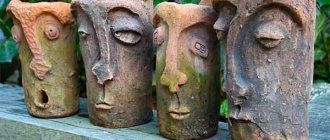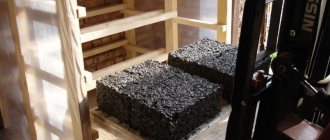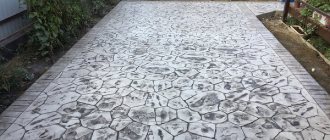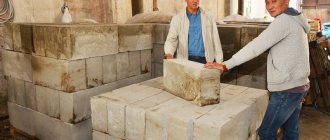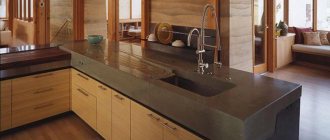Hello dear readers. In today's article we will tell you how to properly make pigment for concrete with your own hands. We sincerely hope that the information received will bring you maximum benefit, and that you will return to our site more than once in search of answers to your questions.
Most people are used to gray concrete. However, thanks to the latest developments in construction, this material has received a very different color palette of shades. And it happens like this: a special powder is added to the cement mortar, which makes it possible to create any color scheme. Often this coloring is used for sidewalks, paving stones and curbs, and sometimes multi-colored concrete is used to decorate small particles on the facades of premises.
To properly color concrete, it is necessary to add powder dyes when mixing it. Pigments are special additives that give the finished product a certain color shade. Such dyes come in the form of microcapsules, emulsions or concentrate pastes.
The following properties of the pigment composition can be distinguished:
- coloring power and hiding power,
- dispersion and oil absorption,
- alkali resistance and light resistance.
Using this material in practice, you can decorate any yard. There are a large number of painting methods, but if you understand them, having studied all the pros and cons, then it will not be so difficult to do. In addition, made by hand, it has a high coloring ability and is resistant to environmental influences, intense light and high temperature.
Various color solutions are becoming increasingly popular in construction. This is especially true for concrete pigments, which are added to a special solution during mixing or applied to an already prepared surface.
At the same time, the components that convey color can be synthetic and natural, and the saturation depends on the amount of chemicals in the solution. For example, to get a red tint, you need to oxidize iron. If we talk about white color, then double oxidation of titanium will be required.
More natural additives for coloring include components such as:
- chrome and red lead,
- manganese and iron.
It is in this way that you can easily obtain many dyes for concrete.
Do-it-yourself pigment for concrete - the correct painting technology
Hello dear readers. In today's article we will tell you how to properly make pigment for concrete with your own hands. We sincerely hope that the information received will bring you maximum benefit, and that you will return to our site more than once in search of answers to your questions.
Most people are used to gray concrete. However, thanks to the latest developments in construction, this material has received a very different color palette of shades. And it happens like this: a special powder is added to the cement mortar, which makes it possible to create any color scheme. Often this coloring is used for sidewalks, paving stones and curbs, and sometimes multi-colored concrete is used to decorate small particles on the facades of premises.
To properly color concrete, it is necessary to add powder dyes when mixing it. Pigments are special additives that give the finished product a certain color shade. Such dyes come in the form of microcapsules, emulsions or concentrate pastes.
The following properties of the pigment composition can be distinguished:
- coloring power and hiding power,
- dispersion and oil absorption,
- alkali resistance and light resistance.
Using this material in practice, you can decorate any yard. There are a large number of painting methods, but if you understand them, having studied all the pros and cons, then it will not be so difficult to do. In addition, made by hand, it has a high coloring ability and is resistant to environmental influences, intense light and high temperature.
Various color solutions are becoming increasingly popular in construction. This is especially true for concrete pigments, which are added to a special solution during mixing or applied to an already prepared surface.
At the same time, the components that convey color can be synthetic and natural, and the saturation depends on the amount of chemicals in the solution. For example, to get a red tint, you need to oxidize iron. If we talk about white color, then double oxidation of titanium will be required.
More natural additives for coloring include components such as:
- chrome and red lead,
- manganese and iron.
It is in this way that you can easily obtain many dyes for concrete.
Simple option
We were also suggested to use simple dyes for concrete with our own hands. They, like acidic ones, have a powdery appearance. The advantage of such dyes is that they are easy to mix and have a large number of colors.
When buying such a dye, we would have to be very careful in our choice, since if we buy poor quality paint, we can constantly tint certain places in the future. Because such material quickly fades in sunlight, and is very weak to natural disasters.
What can act as a dye for concrete?
Substances that can add color to a concrete structure can be natural or synthetic. For example, using red iron oxide you will achieve a red color in the product, and titanium dioxide will achieve white. Also representatives of mineral coloring additives are red lead, chromium oxide, manganese, etc.
By the way, these additives themselves can be added to concrete, both during the process of mixing it, and after it has hardened directly to the surface. The first option, of course, is preferable, since in this case the color is distributed more evenly and is preserved even despite wear and tear over time.
And the amount of dye added to the solution will tell how saturated the color will turn out. So be careful when choosing a shade and calculating the proportions of the ingredients of the mixture, because the cost of such pigments is quite high, which naturally affects the final price of the finished color product.
Material characteristics
Based on the chemical composition of the dye, one can judge its features, including resistance to corrosion, chemicals and high temperatures.
Modern production technology makes it possible to obtain pigments that will have different structural forms (emulsions, pastes, microcapsules), and all of them can be added to the solution with your own hands at the time of its preparation. The choice of the required material will be determined by certain requirements and rules, as well as the characteristics of the substrate being processed and the climatic conditions in which the object to be painted is located.
Lightfastness
In the case of external objects, considerable demands are made on the lightfastness of the paint: when it gets into the solution, it must retain its shade, despite exposure to ultraviolet radiation. As a rule, natural pigments, which can be used to make colored concrete, have high light resistance, and synthesized components can fade over time from the scorching sun.
Unlike paints used to color plastic or metal, compositions for hardened surfaces penetrate deeply into the structure, impregnating the solution. The degree of staining directly depends on the type of pigment carrier.
How to mix colored concrete
Mixing concrete is a dusty job. But if you want to more evenly distribute your desired color throughout the entire structure, then, of course, the best option would be to add dye while the solution is being mixed .
If suddenly some time passes and the topmost coating is damaged or completely erased, then know that your product, so to speak, will not lose its strength. It will still have a very attractive and beautiful style and appearance from the outside.
The very degree of protection will directly depend on the amount of dyes that were introduced into a given solution. But remember that in terms of price category, it will cost quite more. That is why colored concrete costs many times more than plain concrete. But if you don’t want to buy, but make your own pigments for concrete, then it will cost much less.
To make such a solution, and with your own hands, you must comply with the conditions, proportions and criteria : one part cement, two and a half parts sand, about four parts finer gravel, one part water and, of course, dye, without which you simply cannot live.
In order to get the maximum effect , it is necessary to use white sand in combination with cement of the same color. Only then will you be able to get a very pleasant and beautiful color that will contain a minimum amount of pigments; in principle, you can make a dye for concrete with your own hands.
Before combining a substance that will color the solution, it must first be diluted in a sufficiently small amount of water. You need to pour this solution very carefully and at the same time, you should not rush. Do not forget that the mixture must be constantly stirred so as not to get lumps. After all, all subsequent processing depends on how to mix the mixture.
Making Tips
An unattractive and dull color can be replaced with any other shade. There are several ways to do this. As a rule, the necessary substances are added while mixing the solution.
To paint a finished reinforced concrete product, you can use a special paint, and if you want to save money, it is better to use dyes while the structure is being poured.
This type of pigment easily dissolves in water. For concrete mortar it is better to use alkyd or acrylic paint. Experienced construction specialists know how to use not only dry pigments, but also a wide variety of emulsions, paste concentrates and microcapsules with fillers.
Preparation of concrete mixture with dye
Ensuring uniform and deep coloring of the product is achieved by adding dye to the concrete mixture. Moreover, it should be added precisely at the stage of its preparation.
Experts also recommend distributing the coloring matter evenly over the base, which can significantly reduce the final time for preparing the colored concrete mixture. The more carefully this procedure is performed, the faster the final result. An indicator of the readiness of the mixture is the presence of a uniform color, regardless of where the solution is taken to assess the level of coloring. Compliance with the proportions will ensure that the concrete mixture is prepared with the same level of coloring from batch to batch. At the same time, the irrational use of dyes can not only change the final color of the concrete mixture, but also significantly increase the costs of its preparation, because such dyes are quite expensive.
Popular manufacturers
The construction market has a wide range of pigment colors from various manufacturers. Let's get acquainted with the most popular brands of coloring products. With their help, you can make a multi-colored solution with your own hands, and use it in arranging and decorating your personal plot.
Fepren (Czech Republic)
The company produces high-quality dyes that have deep shades and high color fastness. They have excellent contact with cement and are evenly distributed in the mortar mass.
Promindsa (Spain)
Leader in the production of iron oxide pigments. The production uses a new technology for grinding raw materials, thanks to which the coverage of the area with the active substance is significantly increased.
Yipin Pigments (China)
The international group produces high quality products and exports them throughout the world. The company's pigments successfully compete with similar products due to decent strength properties and low prices.
Penetrating painting of concrete surfaces
This painting method is the same as regular painting of products. But it is worth considering that during hardening, the cement composition retains its moisture absorption properties. This property is used for additional protection of the cement surface and for its coloring.
Painting recommendations:
- For coloring, you should use bases with deep penetration, capable of being absorbed to a depth of 5 mm;
- Water-based impregnations are not suitable for cement products. This is because these components have low penetration levels and will leach out over time;
- When choosing dyes, be sure to carefully read the composition. Mixtures must be designed specifically for penetrating coloring. You can also use varnishes and cement impregnations for the base;
- It is advisable to use this coloring for products that are not subject to significant loads.
Properties of dyes
The composition of the coloring matter determines its technical characteristics, including: • chemical resistance;
• temperature resistance;
• susceptibility to corrosion.
A high-quality pigment must have the following properties:
• good hiding power, which allows you to completely hide the color of the concrete surface;
• dispersion – the presence of small particles that can color the concrete mixture;
• inertness to corrosion;
• resistance to alkaline environment;
• oil absorption, which consists in retaining oily substances on the surface inside the painted layer (oil, as is known, reduces color saturation).
DIY concrete pigment
If it is not possible to purchase ready-made pigment for concrete, you can make it yourself. For this you will need:
DIY concrete pigment.
- dry lime paint of the desired color - 500 g;
- calcium chloride - 240 ml;
- fluff lime - 1.5 kg;
- laundry soap - 30 g;
- clean water at room temperature - 6 l;
- 3 containers with a volume of approximately 10, 2 and 0.5 liters.
Calcium chloride (sold in granules) is a surface set accelerator and antifreeze additive. The composition of lime paints includes aluminum alum, calcium chloride and dyes - mineral inorganic pigments, so the range of colors is not rich, light shades predominate. You can also prepare lime paint yourself; its components are commercially available.
- Pour lime into a bucket and gradually, stirring, pour in 5 liters of water.
- In a smaller container, combine the dye with water to obtain 1 liter of liquid paint, add calcium chloride.
- Grind the soap and add a small amount of hot water.
- Pour the soap and paint mixture into the lime mortar, mix and strain.
Mixing process
To make colored concrete at home with your own hands, at the mixing stage, pigments are added to the solution, which interact with water and give it the desired color. The intensity of the shade is regulated by the amount of product that is introduced into the building mixture. In this way it is possible to color the entire mass evenly. This has an undeniable advantage, since as the surface wears away, the color of the concrete coating will not change.
It is worth noting that this technology significantly increases the cost of the cement mixture, because to obtain bright shades you need to add a considerable amount of expensive pigment to the solution that you will prepare with your own hands.
Sequence of work
To obtain the desired color of concrete, you must carefully study the instructions for use that come with the colorant. It indicates the proportions in which the pigment should be added to the solution. On average, to obtain lightly colored concrete, you need to ensure a pigment to cement ratio of 1:100, for medium color – 2.5:100, for intense color – 4.5:100. To prepare the building mixture we will need:
- Cement – 1 part.
- Sand – 2.5 parts.
- Fine gravel - 3.5 parts.
- Water – 1 part.
- Dye - according to the recommendations on the package.
Before the pigment is mixed into the solution, it must be dissolved in a small amount of water. The resulting dye is slowly introduced into the concrete while stirring it, without stopping the process. The quality and uniformity of coloring will depend on how well the kneading is done.
Painting methods
Coloring concrete mortar can be done using two methods:
- At the stage of preparing the mixture;
- After the concrete has hardened.
The first method is considered more appropriate, since concrete painted during manufacture has a longer service life. In addition, the paint layer does not have to be refreshed periodically.
The process of painting concrete using the second method is similar to the procedure for painting the walls of a building. However, it is worth remembering that in your work it is necessary to use pigments that can penetrate deep into the monolith (at least 2 mm). If you ignore this requirement, the quality characteristics of the dye will significantly decrease.
Why do you need wear-resistant paint?
Wear-resistant paint is needed to protect concrete floors from wear and tear. The durable coating protects concrete from abrasion, scratches and other mechanical damage.
To make homemade concrete paint you will need the following materials:
- petrol;
- solvent;
- Styrofoam;
- pigment color.
You might also be interested in reading the article: how to join two pipes using a plastic bottle
.
The author of the YouTube channel “Vadim Pratashchik” shared his personal experience in making homemade wear-resistant paint for concrete floors.
Types of concrete painting
There are a large number of methods for painting concrete structures. Each has its own characteristics, positive and negative qualities. There are two painting methods:
- applying paint to the finished material;
- mixing cement mortar with pigment.
- dry;
- acidic;
- simple;
- color additives;
- acrylic.
The first option is similar to regular wall painting and involves painting large completed structures. To work with concrete, compositions are required that can penetrate to a sufficient depth, and not just create a surface colored layer.
The immersion of the pigment reaches 1−2 mm deep into the material. As this indicator increases, color fastness increases, which is especially important for concrete structures that absorb moisture well and are subject to abrasion and exposure to the sun.
Adding colorant while mixing concrete is the most reliable method. Material created in this way does not require touch-up and lasts for a long time. High cost is the main disadvantage of this option. To obtain a uniform and rich color, a large volume of expensive pigment is required.
Dyes include several types:
Acid dyes
The most popular painting option. It uses a transparent powder that does not have a harmful effect on humans. When interacting with the material, a reaction occurs and the desired shade is obtained.
The color palette includes red, green, black, yellow and white concrete stain. The required tone is achieved by increasing the concentration of the substance or mixing several shades. Components that will be needed for work:
First, combine the dry ingredients and then add the liquid. A solvent is applied to the material. The pigment is distributed using a sprayer; the surface must be dry and clean. You can also use a brush without metal inserts that is acid-resistant.
Objects located nearby must be covered with a protective material - the acid-containing substance has a detrimental effect on compounds with low strength. For personal safety, gloves and a special suit are worn.
Six hours after application, the remaining acid and coloring pigment are removed with water. Within a day, the structure will completely dry and be ready for use. This method can artificially age concrete or create an imitation of stone on its surface. The dye consumption is on average 0.25−0.35 liters of solution per 1 square meter. m.
What is pigment
The concrete is too gray to not want to paint it. Well, you can easily change the situation. There are pigments for this.
Pigment is a dye in the form of a dry powder. It is added when mixing solutions or applied to the finished surface. For supporters of a healthy lifestyle, there is a whole series of paints that are made from natural materials:
- crushed limestone, chalk;
- kaolin powder;
- graphite pigment;
- crushed umber;
- manganese peroxide;
- ground ocher;
- iron lead (it’s been decided, that’s what I’ll name my future cat).
Like everything natural, natural colors are restrained and modest. Those who are for brightness, “no matter what,” can look at artificial colors. The first group (still almost natural) consists of minerals that have undergone heat treatment:
- construction paint glaze;
- ultramarine blue pigment made from an alloy of kaolin, soda, sulfur;
- green chromium oxide powder;
- white titanium dioxide pigment;
- crown yellow dye;
- burnt brown umber.
- black pigment from soot;
The second type of concrete ammunition has a metallic sheen. This:
- Golden bronze.
- Silver aluminum.
- Zinc dust.
- cinnabar;
- organic pigments of yellow, scarlet, blue and red colors.
The most daring are acid dyes. As the name suggests, they are acid-based. Most often these solutions are transparent. They acquire their color when they interact with concrete. Then you get bright, saturated colors of blue, black, green, brown.
For the convenience of our selection and use, caring manufacturers put pigments in different packages:
- dry paint in bags;
- emulsions in jars;
- pastes in tubes;
- concentrates in microcapsules.
I just want to add to this variety a handful of pickled milkweed and a bunch of mandrake roots (just kidding). It is worth adding that, despite their origin, all dyes are safe for humans.
How to make and use?
Concrete products are painted in two ways:
- painting the finished product;
- preparing a color mixture.
It is preferable to paint large-scale concrete structures after construction and complete settlement. The coloring composition must penetrate deeply into the structure of the product; single-layer, surface paints are not used. The best option would be a substance that has the property of penetrating 1-3 mm deep into concrete. The durability of the color depends entirely on the depth of its penetration.
Criterias of choice
The correct choice of dye will affect the resulting color and quality of the product. Before making a purchase, experts recommend paying attention to some characteristics of the composition. A good product must have:
- resistance to alkaline concrete environment;
- light and weather resistance;
- high coloring power.
When purchasing ready-made mixtures from trusted manufacturers intended for concrete surfaces, you don’t have to worry about stability. It’s another matter when such a dye is prepared independently at home.
Almost all high-quality products are characterized by good resistance to weather conditions: humidity, temperature changes and high solar activity. The percentage of dye in concrete should not exceed acceptable standards, since excess will negatively affect the material itself. READ Types of glue for linoleum on concrete floors and gluing technology
The coloring power of a composition almost always depends on the fineness of the pigment. Finer particles will penetrate the material better. Another important feature is that the pigment must firmly adhere to the cement, enveloping its particles, and not dissolve in water. This will improve color fastness. This characteristic should be taken into account by all those who want to independently prepare a concrete dye for paving slabs and other products.
Factory-made formulations meet all these requirements, but those prepared at home may be inferior in certain properties.
